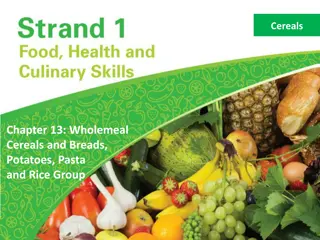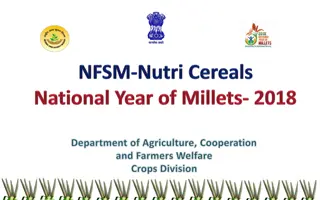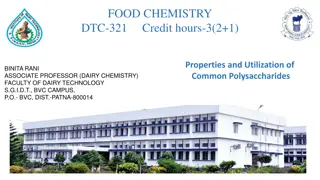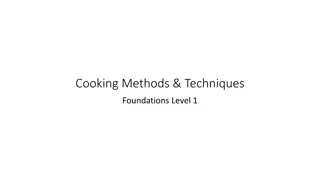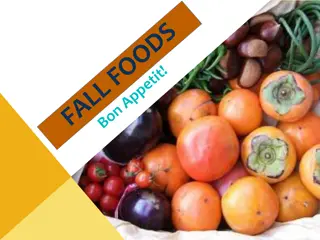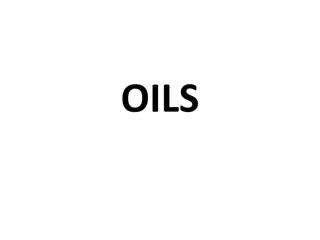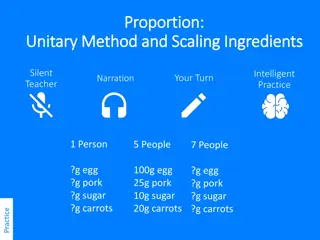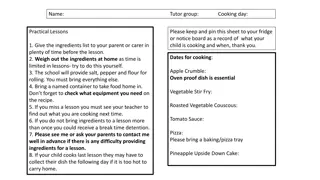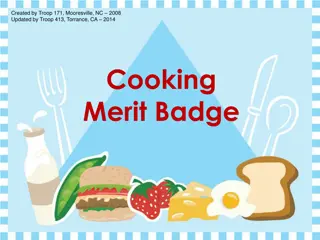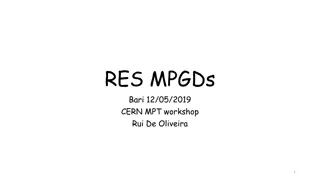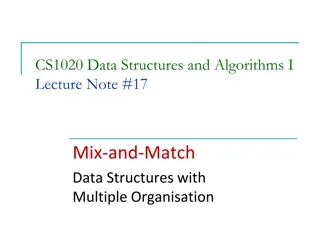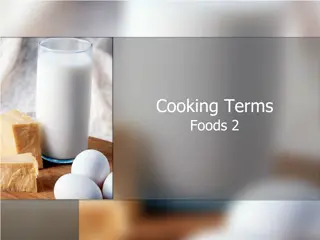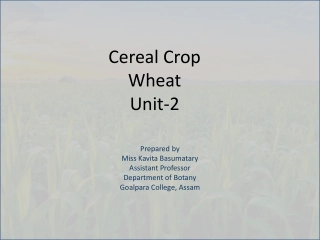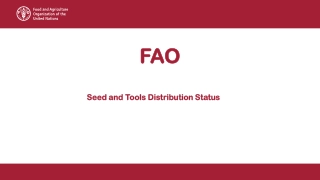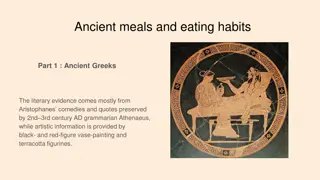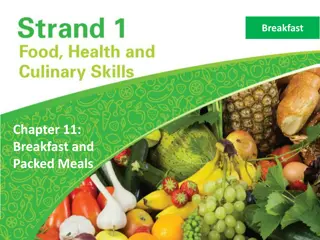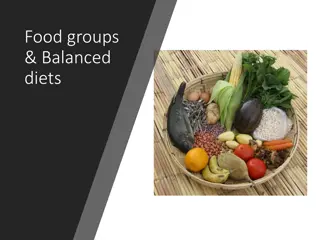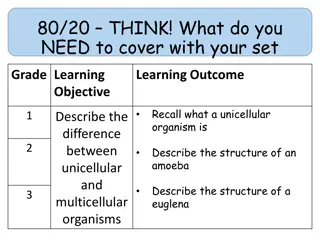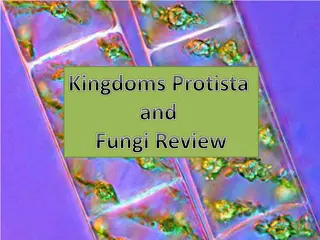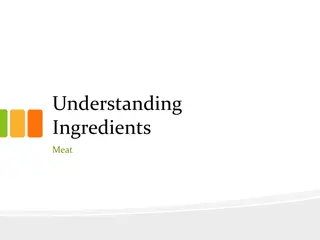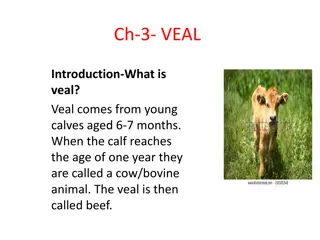Exploring the World of Cereals: From Structures to Uses in Cooking
Delve into the realm of cereals with an in-depth look at their structures, nutritive value, and significance in human diets. Discover the six major types of cereals, their cultivation, and their essential role as a staple food globally. Explore the diverse uses of cereals in cooking and gain valuable insights into their storage, labeling, and more.
Uploaded on Sep 11, 2024 | 0 Views
Download Presentation

Please find below an Image/Link to download the presentation.
The content on the website is provided AS IS for your information and personal use only. It may not be sold, licensed, or shared on other websites without obtaining consent from the author. Download presentation by click this link. If you encounter any issues during the download, it is possible that the publisher has removed the file from their server.
E N D
Presentation Transcript
Understanding Ingredients Cereals
Topics Introduction Structures of Cereals Nutritive Value of Cereals Choice and Storage of Cereals Types of Cereals Uses of Cereals in Cooking / Diet Food and Nutrition Labelling of Cereals 2
Introduction Cereal is the edible seeds of various plants belonging to the grass family The six major types of cereals are rice, wheat, maize, oat, barley and rye Cereals have been an essential part of the human diet since the beginnings of agriculture in the first millennium B.C. 4
Introduction They can be grown in a large part of the world and provide the staple food for most of mankind Cereal consumption has declined in industrial countries over the last century But remain the most important crop in the third world, where it is the major source of food energy up to 90% of protein intake, compared to a mere 25% in industrialized countries 5
Worlds cereal production expressed as percentage Data: Food and Agriculture Organization of the United Nation (FAOSTAT) data corresponding to 2010 Sorghum, 2%Others, 3% Barley, 5% Corn, 35% Wheat, 27% Rice, 28% 6
Structures of Cereals Most cereals belong to the family of grasses Most grains share a common structure The proportions constituted by the different parts vary from one cereal to another The cereal grain (caryopsis) consists of three main parts: Outer layer (the bran) Endosperm (or kernel) The germ 8
Structures of Cereals The seed is enclosed in an outer shell, or hull, that cannot be assimilated by the human digestive system Endosperm (or kernel) Therefore, the grains must be hulled to make them edible Outer layer (the bran) Germ A wheat kernel 9
Structures of Cereals Bran: coarse outer protective coating Enclosing the kernel Made up of several fibrous layers Included in wholemeal flour Rich in vitamins (especially vitamin B complex) and minerals (such as calcium, iron, and phosphorous) Plays an important role in the functioning of the gastrointestinal system by helping to prevent constipation 10
Structures of Cereals Endosperm (kernel): the starchy store of food The largest part of the grain Composed mainly of starch, a complex carbohydrate that is absorbed slowly by the body, producing a long-lasting feeling of satiety 11
Structures of Cereals Germ: the plant embryo Located in the lower end of the grain Contains the seed of a new plant Small in size Often separated from flour in milling (included only in wholemeal flour) Can be processed into oil of cereals, e.g. corn oil Has the highest concentration of nutritional elements, including various vitamins, minerals, proteins, and also a high level of fat, which makes it perishable 12
Nutritive Value of Cereals Different parts in a cereal grain provide different nutrient profiles: Bran provides: Vitamin B complex Minerals such as calcium, iron, and phosphorous Dietary fibre Endosperm provides: Complex carbohydrate Plant proteins (plant proteins in cereal are low biological value proteins) Germ provides: Fat Plant proteins (plant proteins in cereal are low biological value proteins) Vitamin B complex Minerals such as iron 14
Choice and Storage of Cereals 15
Choice and Storage of Cereals Choose cereals which are well-packed, dry and firm, without an unpleasant smell and weevils Best kept in airtight containers in a cool dry place Check the expiry date of the cereal products and use accordingly 16
Choice and Storage of Cereals Choosing rice Note the type of rice need Check the expiry date Should be dry and firm Should not contain sand nor weevil Storing rice Cover rice and store in a cool, dry place Use rice according to its expiry date Cover and store cooked rice in the refrigerator away from strong-smelling foods 17
Choice and Storage of Cereals Choosing flour Note the type of flour need Check the expiry date Buy in the amount needed as flour cannot be kept long Storing flour Keep in air-tight containers Store in a cool, dry place Use flour according to its expiry date 18
Types of Cereals Common cereal crops Pseudo-cereals Wheat Rice Barley Corn or maize Millet Sorghum Oat Rye Wild rice Spelt Buckwheat Quinoa Amaranth They are pseudo- cereals because they do not belong to the grass family. 20
Worlds cereal used as food expressed as percentage Data: Food and Agriculture Organization of the United Nation (FAOSTAT) data, 2013 Rice (Milled Equivalent), 37% Wheat and products, 45% Maize and products, 12% Cereals, Other, 1% Sorghum and products, 2% Rye and products, 1% Millet and products, 2% Barley and products, 1% 21
Types of Rice In over 8,000 varieties, rice can be classified according to grain length and texture They are generally divided into short grain (or round grain), medium grain, and long grain types Short grain rice or round grain rice ( ) measures 4 to 5 millimeters in length and 2.5 millimeters in width; its higher starch content makes it stickier when cooked Medium grain rice ( )(5 to 6 millimeters long) is slightly shorter and plumper than long grain rice, these varieties remain firm and light when cooked but tend to stick when cooled Long grain rice (6 millimeters and over) is light, and the grains remain separate when cooked; however this rice can become sticky if it is overcooked or stirred too frequently during cooking 22
Types of Rice The market offers several kinds of rice with different kinds of textures: Brown rice is the whole grain with the fibrous inedible outer husk removed. Brown rice is the most nutritious form of rice; its nutty flavour is stronger than that of white rice. White rice has been hulled and polished, stripping it of a significant proportion of its nutrients. Compared to brown rice, it is much lower in niacin, thiamine, magnesium, zinc, iron, and fibre. Arborio rice is a classic round white rice that is the essential element in Italian dish. It is considered to be one of the finest types of rice. Glutinous rice has a white and opaque appearance. The starch of glutinous rice consists almost entirely of amylopectin. It has a tendency to stick together after cooking. 23
Types of Wheat Flours Wheat is commonly milled into wheat flour Wheat kernels Three basic flour categories: White flour: usually 75% of the whole wheat grain Wholemeal flour: 100% made from the whole wheat grain with nothing added or taken away Brown flour: usually contains about 85% of the original grain Storage Cleaning Milling Storage of flour Dispatch A simplified flow-chart of wheat milling 24
Types of Wheat Flours Two flour categories are commonly used: White flour Wholemeal flour Bran, germ, fat and some of the minerals are removed White in appearance Fine and smooth in texture The husk is removed The bran, germ and endosperm are kept Contains more nutrients than white flour Light brown / dark brown in colour Rough in texture 25
Types of Wheat Flours Wheat protein Wheat proteins account for about 10 15% of the grain dry weight Four major types of protein: Albumins Globulins Gliadins Glutenins 20% of the endosperm protein, important in metabolism 80% of the endosperm protein, gluten protein The protein content is linked to the compactness of the gluten network Flours are subdivided according to their end-use: Strong flours used in bread baking Medium flours, all-purpose Weak flours used in making cake and biscuit 26
Types of Wheat Flours Wheat protein (cont d) Gluten is the protein found in wheat flour It becomes sticky and elastic when mixed with water In cooking flour mixture, the gluten helps form its shape and texture The amount of gluten in different types of flour varies 27
Types of Wheat Flours - High protein content Strong flour - 12-14% gluten content - Mainly for making bread White flour Type of wheat flour - Also called all-purpose flour Plain flour - 10-12% gluten content - Suitable for a variety of uses - Lower protein content Weak flour - 8-10% gluten content - Suitable for making cakes and biscuit Wholemeal flour - Raising agent added Self-raising flour - 10% gluten content - Suitable for sponge cake and scones 28
Types of Wheat Flours Wheat flour is low in fat It provides protein, a variety of vitamins, particularly Vitamin B complex, and a range of minerals Wholemeal flour contains more fibre, vitamin B and fat than white flour 29
Comparison of Nutrient between White Flour and Wholemeal flour Wheat flour, white, all- purpose, unenriched Wheat flour, whole-grain (Value per 100 g) Energy (kcal) 364 340 Protein (g) 10.33 13.21 Total lipid (g) 0.98 2.50 Carbohydrate (g) 76.31 71.97 Total dietary fibre (g) 2.7 10.7 Calcium (mg) 15 34 Iron (mg) 1.17 3.60 Phosphorous (mg) 108 357 Thiamin (mg) 0.120 0.502 Riboflavin (mg) 0.040 0.165 Niacin (mg) 1.250 4.957 Vitamin B-6 (mg) 0.044 0.407 Source: United States Department of Agriculture, May 2016. 30
Other Types of Flours Flour and their cereal sources: Wheat Rice White flour Wholemeal flour Tang flour Rice flour Glutinous rice flour Durum wheat Maize Cornflour Semolina 31
Other Types of Flours Tang flour Milled from the endosperm with the gluten removed Flour mixture made with tang flour looks clear when cooked Semolina Coarse middlings from other varieties of wheat durum Create soft doughs, easy to shape into pasta The dough is relatively plastic, contrasting with the strong elastic doughs obtained from bread flours Commercially produced dry pasta is made almost exclusively from durum semolina Cornflour Also called corn starch Used to thicken sauces 32
Other Types of Flours Rice flour Used in some Chinese pastries, dim sum and rice noodles Glutinous rice flour Made from glutinous rice Contains almost 100% amylopectin Very sticky Used in making glutinous rice balls and other Asian cuisines 33
Uses of Cereals in Cooking / Diet 34
Uses of Cereals in Cooking / Diet Some cereals are eaten as they are, for example: Rice Maize Most of the cereals are processed and used to produce a range of products, for example: Wheat Oats 35
Uses of Cereals in Cooking / Diet Wheat Rice Maize Breakfast cereals Bread and cakes Pasta and noodles Pizza Steamed rice Congee Dim sum Rice cakes and desserts (e.g. Mango with Glutinous Rice) Rice noodles Breakfast cereals, e.g. rice crispies Rice wine Tortilla Cornflour Corn oil Cornflakes Popcorn 36
Uses of Cereals in Cooking / Diet Oat Barley Rye Biscuits Oatmeal Barley drink Barley in soup Rye bread Rye beer 37
Uses of Cereals in Cooking / Diet Product from wheat flour Wheat flour may be mixed with water to form a dough The dough is further processed into different shapes to form noodles, pasta and ready-made wrappings Fresh noodles and ready-made wrappings should be stored in refrigerators and used within 2-3 days Store dry noodles and pasta in air-tight container, keep in a cool, dry place Store frozen spring roll wrappings in the freezer 38
Uses of Cereals in Cooking / Diet Noodles Noodles are a popular form of pasta They are made from a paste of flour and water The flour may be made from wheat or rice Sometimes, egg or shrimp roe is added Noodles are long and thin; they come in different shapes They may be very fine, like vermicelli, or broad and flat 39
Uses of Cereals in Cooking / Diet Noodles (cont d) Noodles may be eaten as a snack or as part of a main meal Instant noodles are pre-cooked and may be quickly reheated Like rice, noodles form the starchy, energy-giving part of a meal Noodles may be cooked: by boiling, e.g. plain boiled noodles by frying, e.g. fried rice noodles with beef by stewing, e.g. stewed noodles with pork and mushrooms in soup 40
Food and Nutrition Labelling of Cereals 41
Food and Nutrition Labelling of Cereals Labelling of cereals is controlled in Hong Kong legislation: List of ingredients Pre-packaged food shall be legibly marked or labelled with a list of ingredients List of allergenic substance Cereals containing gluten (namely wheat, rye, barley, oats, spelt, their hybridized strains and their products) is an allergenic substance, the name shall be specified in the list of ingredients Appropriate durability indication Indication of best before or use by date 42
Food and Nutrition Labelling of Cereals Labelling of cereals is controlled in Hong Kong legislation: Nutrition labelling Pre-packaged food shall be marked or labelled with its energy value and nutrient content Nutrition claim If any nutrition claim is made on the food label or in any advertisement, the nutrient in concern shall be marked or labelled in the nutrition labelling 43
References FAO statistical pocketbook 2015: world food and agriculture. (2015). Rome: Food and Agriculture Organization of the United Nations. Food Composition Databases, Agricultural Research Service, United States Department of Agriculture, May 2016 Simpson, B. K. (2012). Food biochemistry and food processing. Ames, IA: Wiley-Blackwell. Zhou, W., & Hui, Y. H. (2014). Bakery products science and technology. Oxford: Wiley-Blackwell. 44


